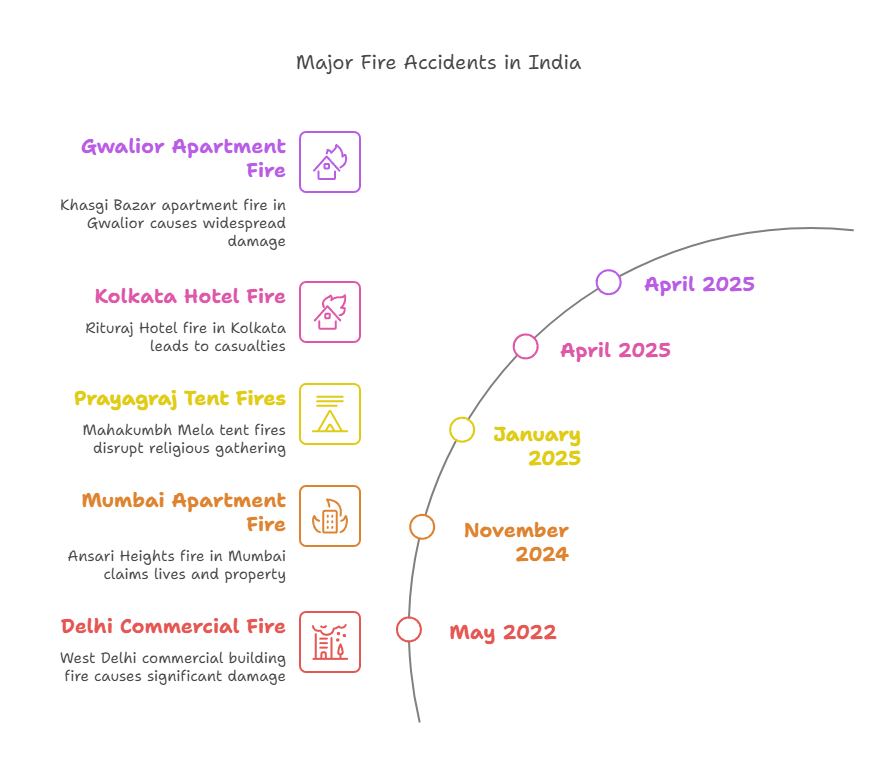Disaster Management
Fire Safety in India
- 08 May 2025
- 8 min read
For Prelims: National Building Code (NBC) 2016, Bureau of Indian Standards (BIS), Model Building Bye Laws 2016.
For Mains: Provision Regarding Fire Safety in India, Issues Leading to Urban Fire in India, Measures to Improve Fire Safety in India
Why in News?
Recent fires in overcrowded buildings across India have become disturbingly common, such as a hotel fire in Kolkata killing 14, including children, and a blaze in Ajmer claiming 4 lives.
Note: According to the Accidental Deaths and Suicides in India (ADSI) report by the National Crimes Records Bureau (NCRB), as many as 7,435 people were killed in over 7,500 fire accidents in 2022.
- Fire Service is a State subject and has been included as a Municipal function in the XII Schedule of the Constitution of India under Article 243(W).
Major Fire Accidents in India
Why Are Urban Areas Prone to Deadly Fires?
- Urbanisation and Infrastructure Issues:
- Illegal Constructions: Unauthorized buildings violate the 3-meter setback rule, blocking ventilation and fire access. Even approved buildings often use non-fire-resistant materials, with old wiring and overloaded systems raising fire risks.
- Poor Urban Planning: Congested layouts and narrow lanes delay the arrival of fire engines and hinder rescue operations. While National Building Code (NBC) 2016 mandates two enclosed staircases of at least 1 meter width for buildings over 15m, many older buildings with just one staircase become deadly during fires.
- Governance Challenges:
- Political Interference: Illegal colonies are often regularized during elections without fire safety upgrades, while stricter rules like Delhi’s 2019 fire safety amendments have been rolled back under pressure from builders.
- Lack of Public Awareness: Residents and businesses often ignore fire drills and get trapped due to unfamiliarity with exits, while commercial spaces are misused for storage in stairwells or illegal factories in basements.
- Industrial and Commercial Oversights:
- Faulty Machinery and Poor Maintenance: Overheated equipment or unserviced Heating, ventilation, and air conditioning (HVAC) systems in workplaces.
- Unsafe Handling of Hazardous Materials: Chemical spills or gas leaks in factories triggering explosions.
- Climate-Driven Threats:
- Severe heat: Extreme heat caused by climate change leads to excessive use of air conditioners, which can overload electrical systems, and in some cases result in AC compressor bursts, increasing the risk of fire incidents in urban areas.
What are the Key Fire Safety Regulations in India?
- National Building Code (NBC): NBC, developed by the Bureau of Indian Standards (BIS), was first introduced in 1970, with its third edition released in 2016.
- It serves as the primary standard for fire safety in India, offering guidelines on general construction, maintenance, exit routes, and fire safety measures for buildings.
- State governments are required to integrate its recommendations on minimum fire safety and rescue protocols into their local bylaws.
- Model Building Bye Laws 2016: It ensures fire safety through its key provisions like use of fire-resistant materials for construction, installation of fire alarms and detection systems, adequate natural light and ventilation to avoid smoke buildup etc.
- Fire Prevention and Fire Safety Act, 2005: It is designed to ensure fire safety in buildings and must be upheld by all states to consolidate and update laws related to fire prevention and safety.
- Model Bill to Provide for the Maintenance of Fire and Emergency Service for the State, 2019: It offers a model framework for states to manage fire and emergency services effectively.
- Scheme for Expansion and Modernization of Fire Services in the States 2023: It was launched by the Central Government in 2023 after the 15th Finance Commission recommended Rs 5,000 crore to strengthen fire services at the state level.
- Fire Safety Week: Union Health Ministry observes Pan-India ‘Fire Safety Week’ from 21st to 25th April' to raise awareness about fire prevention and safety practices across the country.
- NDMA Guidelines: The National Disaster Management Authority (NDMA) has also laid out guidelines on fire safety at homes, schools, and hospitals.
How can Urban Areas be Made Fire-resilient?
- Infrastructure Modernization:
- Smart Infrastructure: Lowered sidewalks aid fire engine access, while AI detection, self-regulating grids, and fire-resistant materials boost fire safety. Retractable staircases offer extra emergency exits in high-rises.
- Retrofitting Fire-Retardant Materials: Retrofitting buildings with fire-retardant materials (such as flame-resistant paints, coatings, and insulation) can reduce the speed and intensity of a fire.
- Overhauling Firefighting:
- More Breathing Apparatuses: Increasing the number of breathing apparatuses for firefighting personnel ensures more firefighters can enter smoke-filled buildings to conduct rescues without suffocating.
- Safe Industrial Practices:
- Industrial risk management: Industries should phase out the use of hazardous materials and adopt safe storage protocols, ensuring that any chemicals or substances that could contribute to a fire are handled with strict safety measures.
- Climate Resilience:
- Innovative Strategies: Green spaces as firebreaks, water recycling systems for firefighting reserves, and predictive analytics to forecast fire risks can enhance fire prevention and response strategies.
Conclusion
The threat of deadly urban fires is not static—it evolves with climate change, population density, and technological complexity. However, cities are not powerless. By embracing innovation, collaboration, and proactive governance, urban areas can transform into fire-resilient ecosystems capable of withstanding tomorrow’s challenges. The blueprint for fire-resilient cities exists; now is the time to build it.
|
Drishti Mains Question: Q. Unplanned urbanization and population density have exacerbated fire hazards in Indian cities. Discuss with examples. |








